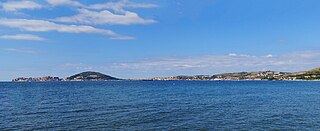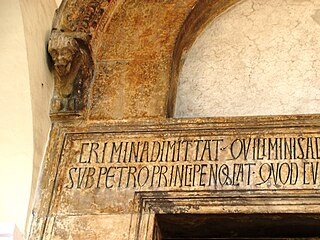Consul was the title of one of the two chief magistrates of the Roman Republic, and subsequently also an important title under the Roman Empire. The title was used in other European city-states through antiquity and the Middle Ages, in particular in the Republics of Genoa and Pisa, then revived in modern states, notably in the First French Republic. The related adjective is consular, from the Latin consularis.

Gaeta is a city in the province of Latina, in Lazio, Southern Italy. Set on a promontory stretching towards the Gulf of Gaeta, it is 120 kilometres from Rome and 80 km (50 mi) from Naples.

The Duchy of Gaeta was an early medieval state centered on the coastal South Italian city of Gaeta. It began in the early ninth century as the local community began to grow autonomous as Byzantine power lagged in the Mediterranean and the peninsula due to Lombard and Saracen incursions.

The Duchy of Naples began as a Byzantine province that was constituted in the seventh century, in the reduced coastal lands that the Lombards had not conquered during their invasion of Italy in the sixth century. It was governed by a military commander (dux), and rapidly became a de facto independent state, lasting more than five centuries during the Early and High Middle Ages. Naples remains a significant metropolitan city in present-day Italy.
Hypatos and the variant apo hypatōn was a Byzantine court dignity, originally the Greek translation of Latin consul. The dignity arose from the honorary consulships awarded in the late Roman Empire, and survived until the early 12th century. It was often conferred upon the rulers of the south Italian principalities. In Italian documents the term was sometimes Latinised as hypatus or ypatus, and in Italian historiography one finds ipato. The feminine form of the term was hypatissa (ὑπάτισσα).
Docibilis II was the ruler of Gaeta, in one capacity or another, from 906 until his death. He was the son of the hypatus John I, who made him co-ruler in 906 or thereabouts.
Richard III, also known as Richard of Caleno, was the Norman count of Carinola and last quasi-independent Duke of Gaeta, ruling from 1121 to his death. From 1113, he was regent of Gaeta for his cousin or nephew, Duke Jonathan; in 1121 he succeeded him. As duke he was a nominal vassal of the Princes of Capua, to whom he was related.
Ptolemy I was the count of Tusculum in the first quarter of the twelfth century. He was a son of Gregory III. Peter Pisanus, in his Vita Paschalis II refers to Ptolemy and the abbot of Farfa as the allies of the emperor in the same way that the Saints Peter and Paul were the allies of the pope.
Richard II, called Richard of Aquila, was the consul and duke of Gaeta, ruling from 1104 or 1105 to his death.

The Archdiocese of Gaeta is a Latin Church ecclesiastical territory or archdiocese of the Catholic Church in southern Italy, in the city of Gaeta, in the Lazio region. The archbishop's cathedra is located in the Cathedral of SS. Erasmus and Marcianus and the Assumption of the Virgin Mary in the episcopal see of Gaeta. A non-metropolitan see, the archdiocese is immediately exempt to the Holy See.
John V was the consul and duke of Gaeta from 1012 to 1032. He was the son of John IV and Sichelgaita, sister of Sergius IV of Naples. He was either very young when he succeeded his father or perhaps he was even born posthumously.
Landulf, either a Lombard count or a Docibilian senator, was the Duke and Consul of Gaeta from 1091 to 1103.

The Norman conquest of southern Italy lasted from 999 to 1139, involving many battles and independent conquerors.
Gualganus, surnamed Ridel, was the third and last Count of Pontecorvo and Duke of Gaeta of the Norman Ridel family from about 1091 until about 1103. He was a son and successor of Duke Raynald Ridel, but his rule in Gaeta was not unopposed.
Richard I was king of England from 1189 to 1199.

The Blosseville Coast is a long stretch of coast in King Christian IX Land, eastern Greenland. Administratively it belongs to the Sermersooq Municipality.
Geoffrey Ridel was a landholder and royal justice during the reign of King Henry I of England.

Robert was a south Italian nobleman who ruled the counties of Airola, Alife, Caiazzo, Sant'Agata and Telese from 1088 until his death. He was the regent of Capua in 1090–93, and was effectively independent of any lord after 1105. He was a major patron of churches and abbeys, and also commissioned several books.
This page is based on this
Wikipedia article Text is available under the
CC BY-SA 4.0 license; additional terms may apply.
Images, videos and audio are available under their respective licenses.






